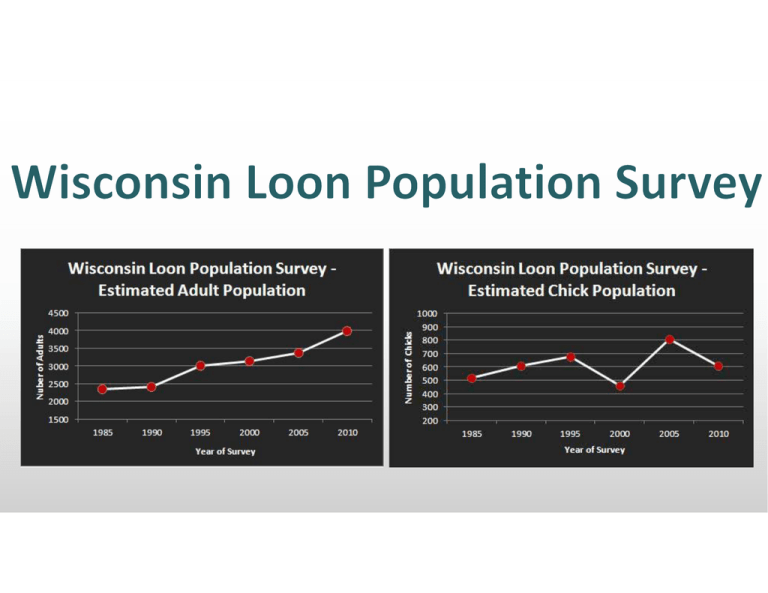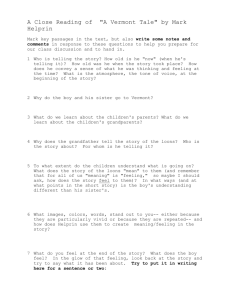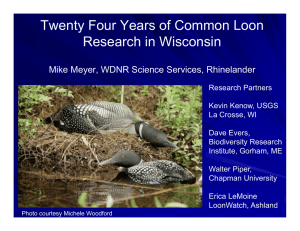Document 12001980
advertisement

How does WLPS differ from the ALMP? WLPS is: • One day survey. Saturday July 18th, between 5:00a.m. and 10:00a.m. • Counting adult loons and loon chicks. NOT counting territorial pairs, floaters, etc. • Survey occurs only on 258 pre‐selected lakes. These lakes were randomly chosen based on all size classes, # of lakes per county, and northern breeding location. They are representative of all lakes in the loon’s breeding area. Photo by Linda Grenzer Recommendations • Make sure you know the lake location – use a Wisconsin Gazeteer or check our website link http://www.northland.edu/loon‐population‐survey.htm • If unfamiliar with the lake, visit at least once before the survey. Protocol • READ THE SURVEY INSTRUCTIONS! • Monitor only the pre‐selected lake(s) you signed up to survey. • Survey for a minimum of ½ hour on Saturday, July 18th between the hours of 5:00a.m. and 10:00a.m., longer depending on lake size and type of boat. • The latest you can survey is at 9:30a.m. so you can finish by 10:00a.m. • Survey forms will not be used if surveys are performed on the wrong date or time. • If you find you cannot survey, contact LoonWatch as soon as possible Protocol • Fill in your form completely • Lines left blank do not mean “0”, they mean no data • Zero is important data too – we need the whole picture of what is happening out there. • Forms lacking data will not be recorded for the Wisconsin Loon Population Survey Protocol http://www.geocommunicator.gov/blmMap/MapLSIS.jsp Protocol • Make sure you look at all parts of the lake during the survey • To survey lakes with irregular shaped shorelines, bays and islands, create a route with enough vantage points to survey the entire lake from land or boat. • Draw your route and vantage points on your map • Bring binoculars and/or a spotting scope to get a good look at all areas of the lake. Protocol • Count only loons on the lake • Listen for calls to find hard to locate loons • Do NOT count loons that: • Fly in and land • Fly over • You hear but do not see. • If in doubt, err on the conservative side. Photo by Linda Grenzer Photo by Linda Grenzer Protocol • Make sure you are able to positively identify loons – adults, juveniles, and chicks Protocol • Make sure you are able to positively identify loons – adults, chicks and juveniles. • Low light and bright light conditions, wind, fog, and rain can make it difficult to see. • Bring binoculars, your survey form and instructions, and a field guide. Protocol • Bad weather or fog? • Wait around for a while. It may get better. • If weather does not improve, you have 2 choices: • Come back the following Saturday • Count as best you can • Be sure to indicate bad weather conditions on your survey form Important to Remember: 1. Be careful – wear life vests if you go in a boat or canoe 2. Try to avoid disturbing the loons as you count them 3. Bring binoculars, spotting scope (if available), pencil, survey form, map, instructions, field guide 4. Remember to check your boat (and boat trailer if applicable) for aquatic invasive species (esp plants) when removing it from the water. We recommend washing your boat before transferring it to a different water body. 5. Have fun! Checklist After You’re Done ____Filled out survey form completely, including additional comments ____Marked survey points/route on your lake map ____Mailed both the completed survey form and lake map back to LoonWatch, 1411 Ellis Ave, Ashland, WI 54806 How does ALMP differ from the WLPS? ALMP is: • An annual monitoring program. Ideally, volunteers monitor once a week from ice‐out to migration. • Volunteers collect productivity and phenology data: arrival date, floaters, territorial pairs, nesting pairs, # of nesting attempts, # chicks, # chicks surviving to 8 weeks. • Volunteers can select the lake(s) they want to monitor. Photo by Linda Grenzer Protocol • READ THE INSTRUCTIONS • Volunteers have the option to participate at an enhanced level – this is very helpful for management recommendations • Check the box above the contact information if you want to participate • Return your monitoring form no later than November 15 Protocol • Fill out basic information about the lake you are monitoring • WBIC # can be found on your lake map • Dates you started and stopped monitoring are very important – did you catch the first nesting attempt? • Want more information about your lake including water quality? Check out the WI DNR website http://dnr.wi.gov/lakes/ Protocol • Let us know • If loons were observed on your lake • If loons stayed for the summer • If territorial pairs were present • If territorial pairs nested • Let us know when you • Observed the first loons on your lake in spring • Observed loon rafts in the fall • # of loons observed in spring and fall Photo by Ray Thielbar Protocol Photo by Linda Grenzer Protocol • Survey Log • Fill out one row for each week you observed loons on your lake • Record the # of floaters, territorial pairs, nesting pairs, and chicks • At the end of the season, use the survey log to fill out the Loon Season Summary Photo by Jon Okerstrom Protocol • Record • # of territories • Give each territory a name • Complete each step as it applies to your observations 1. Were you able to locate the nesting site? Yes No If yes, indicate the type of nesting site used: Island On/near mainland shore ANP Different Lake Other____ Photo by Rich Floyd Protocol • Complete each step as it applies to your observations 2. Type of ownership? Public Private Unknown 3. Did the eggs fail to hatch? Yes No If yes, how was the nest lost? Predation by__________ Water level change Other___________ Unknown Protocol • Complete each step as it applies to your observations 3a. Was there a 2nd nesting attempt? Yes No A 3rd Nesting attempt Yes No If yes, did the nest fail to hatch? [2nd attempt (Yes/No)]; [3rd attempt (Yes/No)] Did loons re‐nest at the same location? [2nd attempt (Yes/No)]; [3rd attempt (Yes/No)] If no, provide new location on map Protocol • Fill in your form completely • Lines left blank do not mean “0”, they mean no data • Zero is important data too – we need the whole picture of what is happening out there. Thank you for learning about loons! Please help us spread the word about how to protect loons and their habitat. Gregory Nelson



